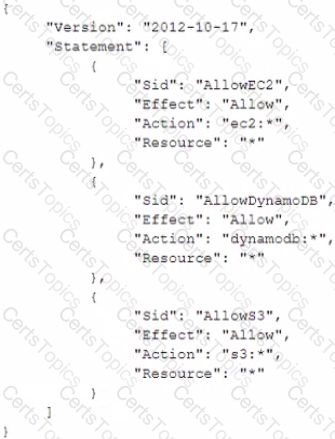A company recently completed the migration from an on-premises data center to the AWS Cloud by using a replatforming strategy. One of the migrated servers is running a legacy Simple Mail Transfer Protocol (SMTP) service that a critical application relies upon. The application sends outbound email messages to the company’s customers. The legacy SMTP server does not support TLS encryption and uses TCP port 25. The application can use SMTP only.
The company decides to use Amazon Simple Email Service (Amazon SES) and to decommission the legacy SMTP server. The company has created and validated the SES domain. The company has lifted the SES limits.
What should the company do to modify the application to send email messages from Amazon SES?
A company is in the process of implementing AWS Organizations to constrain its developers to use only Amazon EC2. Amazon S3 and Amazon DynamoDB. The developers account resides In a dedicated organizational unit (OU). The solutions architect has implemented the following SCP on the developers account:

When this policy is deployed, IAM users in the developers account are still able to use AWS services that are not listed in the policy. What should the solutions architect do to eliminate the developers' ability to use services outside the scope of this policy?
A company has registered 10 new domain names. The company uses the domains for online marketing. The company needs a solution that will redirect online visitors to a specific URL for each domain. All domains and target URLs are defined in a JSON document. All DNS records are managed by Amazon Route 53.
A solutions architect must implement a redirect service that accepts HTTP and HTTPS requests.
Which combination of steps should the solutions architect take to meet these requirements with the LEAST amount of operational effort? (Choose three.)
A company uses a service to collect metadata from applications that the company hosts on premises. Consumer devices such as TVs and internet radios access the applications. Many older devices do not support certain HTTP headers and exhibit errors when these headers are present in responses. The company has configured an on-premises load balancer to remove the unsupported headers from responses sent to older devices, which the company identified by the User-Agent headers.
The company wants to migrate the service to AWS, adopt serverless technologies, and retain the ability to support the older devices. The company has already migrated the applications into a set of AWS Lambda functions.
Which solution will meet these requirements?